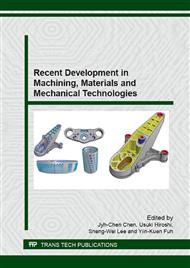p.214
p.220
p.226
p.231
p.237
p.243
p.251
p.255
p.261
Effects of Cooling Conditions on Thermal Crack Initiation of Brittle Cutting Tools during Intermittent Cutting
Abstract:
It is well known that a series of cracks running perpendicular to the cutting edge are sometimes formed on the rake face of brittle cutting tools during intermittent cutting. The cutting tool is exposed to elevated temperatures during the periods of cutting and is cooled quickly during noncutting times. It has been suggested that repeated thermal shocks to the tool during intermittent cutting generate thermal fatigue and result in the observed thermal cracks. Recently, a high speed machining technique has attracted attention. The tool temperature during the period of cutting corresponds to the cutting speed. In addition, the cooling and lubricating conditions affect the tool temperature during noncutting times. The thermal shock applied to the tool increases with increasing cutting speed and cooling conditions. Therefore, to achieve high-speed cutting, the evaluation of the thermal shock and thermal crack resistance of the cutting tool is important. In this study, as a basis for improving the thermal shock resistance of brittle cutting tools during high-speed intermittent cutting from the viewpoint of cutting conditions, we focused on the cooling conditions of the cutting operation. An experimental study was conducted to examine the effects of noncutting time on thermal crack initiation. Thermal crack initiation was found to be restrained by reducing the noncutting time. In the turning experiments, when the noncutting time was less than 10 ms, thermal crack initiation was remarkably decreased even for a cutting speed of 500 m/min. In the milling operation, the number of cutting cycles before thermal crack initiation decreased with increasing cutting speed under conditions where the cutting speed was less than 500 m/min. However, when the cutting speed was greater than 600 m/min, thermal crack initiation was restrained. We applied the minimal quantity lubrication (MQL) coolant supply to the intermittent cutting operation. The experimental results showed that the MQL diminished tool wear compared with that under the dry cutting condition and inhibited thermal crack initiation compared with that under the wet cutting condition.
Info:
Periodical:
Pages:
237-242
Citation:
Online since:
July 2015
Price:
Сopyright:
© 2015 Trans Tech Publications Ltd. All Rights Reserved
Share:
Citation:


